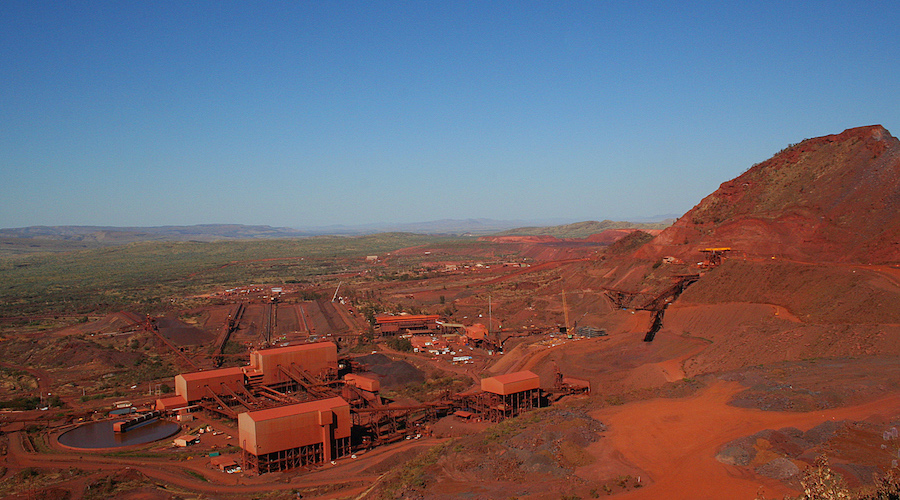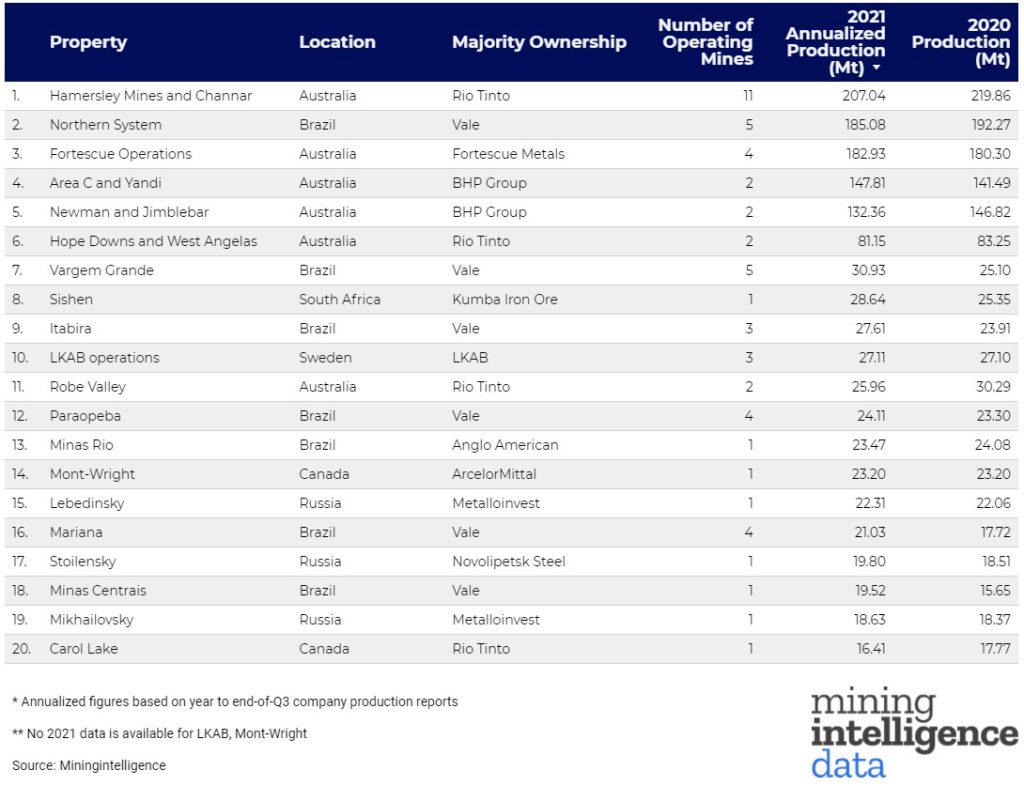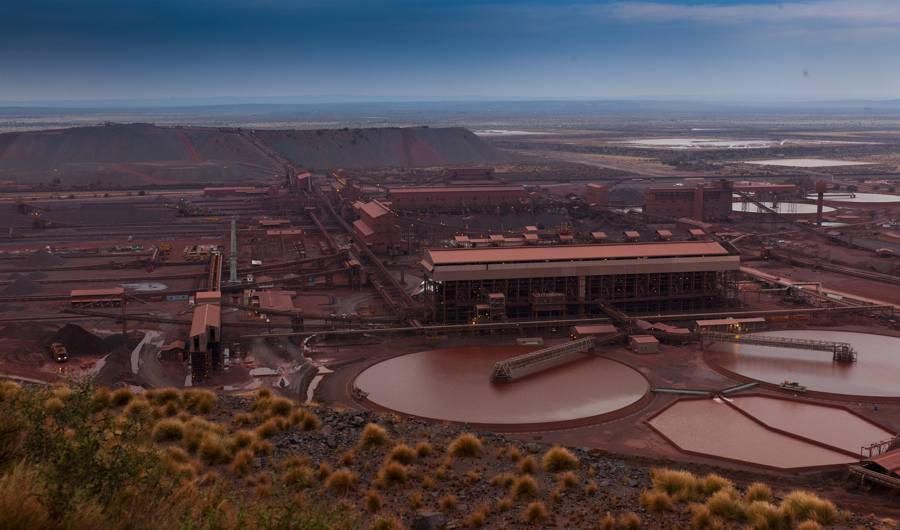RANKED: World’s top 20 biggest iron ore operations


Iron ore is the base metal used to make steel – and steel is the most commonly used alloy in the world. From its first known uses as a metal of antiquity, iron ore has since undergone a transformation from a relic of the industrial age to the driving force behind a commodity supercycle that reshaped the global economy.
According to the World Steel Association, steel demand is forecast to grow by 1%-2% per year over the next decade.
The iron ore price rocketed to record highs this year, reaching US$237.57 a tonne in May as global demand accelerated amid lingering supply threats – a ripple effect of the pandemic – but has since steadied at around US$100 per tonne.
Also read: World’s top 10 biggest mines by tonnes of ore mined
Using data compiled by our sister company Miningintelligence, our latest top ten list ranks the world’s biggest iron ore operations, which are dominated by the world's major miners.

In first place is Rio Tinto's Hamersley Mines complex and Channar with 11 operating mines in Australia's Pilbara region. Based on the figures provided to the end of Q-3 2021, 207 million tonnes of iron ore is forecast for the year. The world's second-biggest miner came under fire when an inquiry found Hamersley Iron failed to protect artefacts belonging to the Wintawari Guruma Aboriginal Corporation after blasting last year. The fallout would see key executives resign, including the CEO, and replaced by leaders with stronger sustainability focuses.
In second place is Vale's Northern System in Brazil's Minas Gerais state, with 5 operating mines expected to produce 185.1 million tonnes of ore this year. In the second quarter, Vale announced and the restart of Serra Leste operations in the Northern System. The expansion includes the refurbishment of an iron ore mill that is scheduled to bring the processing capacity at Serra Leste to 10 million tonnes per year by early 2023.
Taking third place is Fortescue Metals' operations in Australia's iron ore-rich Pilbara region, which include the Chichester, Solomon, Hedland and Western mining hubs, where 182.9 million tonnes of iron ore is expected this year. This month, the world's fourth-biggest miner announced chief executive Elizabeth Gaines will step down as the company extends its transition from a pure play iron ore producer to a green energy and resources firm.
The world's largest miner, BHP, comes in fourth with its Area C and Yandi mines in Australia. This year, 147.8 million tonnes of iron ore is expected. BHP has the green light to go ahead with a planned expansion of its operations in the Pilbara region, cementing its presence for the next 50 to 100 years.
BHP's Newman and Jimblebar mines in Australia's Pilbara take 5th place with a total 132.4 million tonnes of iron ore projected for the year. A few years ago, a US$3.6 billion expansion at Newman and Jimblebar increased BHP’s Pilbara supply chain capacity significantly.
Rio Tinto's Hope Downs and West Angelas mines in Australia's Pilbara are expected to churn out 81.2 million tonnes of iron ore this year. Rio expanded its driverless trucks fleet by introducing 15 autonomous vehicles at West Angeles in 2018.
In seventh place, Vale's Vargem Grande complex in Brazil's five mines are projected to produce 30.9 million tonnes for the year. In a move to reduce dependence on dams, Vale started operations at a waste filtering plant in the Vargem Grande complex, the first of four the company plans to install at sites in Minas Gerais at a cost of US$2.3 billion between 2020 and 2024.

Kumba Iron Ore's Sishen complex in South Africa's Northern Cape province is in eighth place. Based on annualized figures, 28.6 million tonnes of iron ore output is expected this year. Kumba said in February it planned to spend 3.6 billion rand to extend the life of the Sishen mine to 2039 through the ultra-high dense media separation project, expected to begin in the second half of 2023.
Back in Brazil, Vale's three operating mines at Itabira are expected to churn out 27.6 million tonnes of iron ore this year. Itabira is the site of Vale’s first mine. It is also one of ten cities affected by the collapse of the tailings dam at Brumadinho.
LKAB Operations in Sweden, owned by LKAB, has three operating mines set to churn out 27.1 million tonnes of iron ore in 2021. LKAB upgraded its ore processing capability a few years by adding an RMD system as part of a continuous program of expansion in an area that has been home to iron ore mining since the mid-18th century.
Rio Tinto's Robe Valley operations Australia's Pilbara, the Mesa A and Warramboo mines are projected to produce 26 million tonnes of iron ore this year.
Vale's Paraopeba operations in Minas Gerais, has four operating mines expected to churn out 24.1 million tonnes of ore in 2021. In 2019, began cleaning up the Paraopeba river, which was contaminated that year after a dam at the Feijão mine burst.
Anglo American's giant Minas Rio mine in Brazil is forecast to produce 23.5 million tonnes of iron ore this year. Two years ago, Anglo boosted its giant Minas Rio to full capacity after the country’s authorities granted it a key licence for the use of an expanded tailings dam at the site.
ArcelorMittal's Mont Wright mine in Quebec, Canada, is set to produce 23.2 million tonnes of iron ore this year. ArcelorMittal, the world’s largest steelmaker, reported its highest quarterly earnings in 13 years in July, beating expectations, and announcing a new share buyback.
In Russia, Metalloinvest's Lebedinsky mine is forecast to produce 22.3 million tonnes in 2021. Metalloinvest claims the world’s largest iron ore company by reserves by JORC, as its economically recoverable iron ore reserves amount to 15.4 billion tonnes.
Vale’s Mariana mining hub in Brazil consists of four mines, and is expected to produce 21 million tonnes of iron ore in 2021.
Novolipetsk Steel Company's Stoilensky mine in Russia is number 16 in terms of output, forecast to churn out 19.8 million tonnes of iron ore this year.
Vale's Minas Centrais mine in Brazil is expected to produce 19.5 million tonnes of iron ore this year.
Metalloinvest’s Mikhailovsky GOK is expected to produce 18.6 million tonnes of ore this year. Mikhailovsky GOK was the first in Russia to use hematite concentrate, a technology based on flotation plant usage that reduces impound tails and increases production without additional iron ore extraction.
Rounding out the list, Rio Tinto’s Carol Lake, Canada’s largest open-pit iron ore mine, is located in the eastern province of Newfoundland. Carol Lake is projected to produce 16.4 million tonnes of iron ore this year.
Rounding out the list, Brazilian steelmaker Companhia Siderúgica Nacional SA's Casa de Pedra mine in Brazil is expecting 16.4 million tonnes of iron ore output this year.
Download the data at Miningintelligence.
Comments